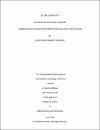CARBON BASED CONDUCTIVE FIBERS FOR FUEL CELL APPLICATION
| Advisor | Elzatahry, Ahmed |
| Author | BUDWAN, BUKR GHAZI AHMED |
| Available date | 2018-12-13T11:04:40Z |
| Publication Date | 2018-06 |
| Abstract | A novel catalyst consists of a group of metals (Ni, Co and Cu) deposited on carbon fiber support and was prepared for oxidation using methanol and ethanol in alkaline medium. The carbon fiber support was fabricated by carbonization of electrospun composite made with an average diameter of 0.2 μm and 0.3 μm respectively and prepared by using electrospinning a mixture of polyacrylonitrile (PAN), polyaniline (PANi) and graphene. Moreover, the composites fibers were characterized with transmission electron microscopy (TEM), scanning electron microscopy (SEM), Energy dispersive X-ray spectroscopy (EDX), X-ray photoelectron spectroscopy (XPS) and X-ray diffraction (XRD). We believe it to be a promising material in the near future. This work focused on the structure of polymeric fibers, which are produced from polymer materials by using electrospinning, such as polyacrylonitrile (PAN), and then verified the conversion of the electrospun fibers to carbon fibers (CFs). This study is divided into several sections: Section 1, Summarized introduction and literature review on theory of electrospinning, parameters and factors affecting the process of electrospinning, applications of this technique, the support materials used and the use of electro-oxidation as a primary factor in fuel cell applications. Section 2, Mainly concerned with the various materials and techniques of the experiments, which were used to study and to reach the target of this thesis. Section 3, Discussion on the results of this thesis, which is separated into three main parts (A, B, and C). Part A, focuses on the preparation of electrospun fibers. It covers the investigation on the effect of various processing parameters and fiber composition preparation and improving a novel approach to fabricate nanocomposite mats. Part B, focuses mainly on the characterization of polymer fibers and carbon fibers composites, based on polyacrylonitrile (PAN). Part C, this part will focus on electrochemical characterization which was used to show the effectiveness of the prepared catalysts represented in (nickel, cobalt and copper) which are deposited by electrochemical technique with chronoamperometry process on carbon fiber ink (cast over glass carbon electrode). Section 4, Includes the conclusion derived from this study followed by References. Section 5, Includes discussion on future work. |
| Language | en |
| Subject | Nanofibers Electrospinning carbon fiber X-Ray Diffraction Polyacrylonitrile Polymer Fibers |
| Type | Master Thesis |
| Department | Material Science and Technology |
Files in this item
This item appears in the following Collection(s)
-
Materials Science & Technology [55 items ]


